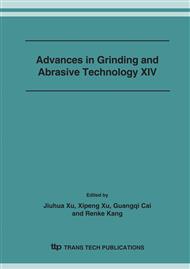p.324
p.329
p.335
p.340
p.344
p.349
p.355
p.360
p.365
Research on Micro-Mechanism of Nanocomposite Ceramic in Two-Dimensional Ultrasound Grinding
Abstract:
Surface microstructure of nano-composite ceramics prepared by mixed coherence system and machined by two-dimensional ultrasonic precision grinding was researched using TEM, SEM, XRD detector and other equipments. Structure, formation mechanism and characteristic of metamorphic layer of ground surface of nano-composite ceramics were researched. The experiment shows micro deformation mechanism of ceramic material in two-dimensional ultrasound grinding is twin grain boundary and grain-boundary sliding for Al2O3, and it is crystal dislocation of enhanced phase, matrix grain boundary sliding, coordination deformation of intergranular second phase as well as its deformation mechanism for nano-composite ceramics. The fracture surfaces of nano-composite materials with different microscopic structure were observed using TEM and SEM. Research shows that ZrO2 plays an important influence on the generation and expansion of crack, and enhances the strength of grain boundaries. When grain boundaries is rich in the ZrO2 particles, the crack produced in grinding process will be prevented, and the surface with plastic deformation will be smooth. The results shows nanoparticles dispersed in grain boundary prevents crack propagation and makes materials fracture transgranularly which makes the processed surface fine.
Info:
Periodical:
Pages:
344-348
Citation:
Online since:
November 2007
Authors:
Price:
Сopyright:
© 2008 Trans Tech Publications Ltd. All Rights Reserved
Share:
Citation:


